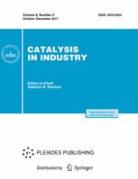CATALYSIS IN CHEMICAL AND PETROCHEMICAL INDUSTRY
The production of olefins by catalytic transformation of methanol on zeolites and zeotypes is of great interest to scientists and specialists in various fringe areas of national economy. Due to implementation of this process on industrial level, the attention gradually shifts from scientific studies devoted to the synthesis and modification of zeolites and zeotypes with different structure to investigation of pilot and industrial plants and determination of the main economic and environmental characteristics of both the existing and the future plants. In 2019, the development of 26 production sites in China with the annual output of 14 million tons of ethylene and propylene was licensed and 14 plants with the total capacity of 7.67 million tons of ethylene and propylene were launched. The created plants provide a complete cycle of coal processing, which consists of coal gasification units yielding syngas, units for the synthesis of methanol and olefins, their refinement and production of polyethylene and polypropylene. The total output of ethylene and propylene at the launched plants was more than 21 million tons. The paper presents a review of publications on the development and modification of catalysts as well as the technological, economic and environmental aspects of olefins production from methanol, which appeared in foreign journals in the recent five years.
The review considers methods for the production of powdered zeolites, which are now manufactured on industrial scale, and granulated zeolite-containing adsorbents and catalysts obtained on their basis; information on the manufacturers of such materials in Russia is provided. Their application in the adsorption dehydration, refinement and separation of gas and liquid media as well as in the catalytic processing of hydrocarbon feedstock in Russia and worldwide is briefly considered.
The paper presents an analysis of the main catalysts and technologies applied for industrial conversion of natural gas to syngas, which is further used to produce ammonia, methanol and hydrogen. The analysis reveals the major trends in their development aimed to reduce the consumption of energy and resources; technological schemes of the processes as well as the catalysts and sorbents used in different steps of methane reforming and steam conversion of CO are described.
A technology for catalytic hydroprocessing of oil residues – atmospheric residue and vacuum residue – aimed to obtain high value added petrochemicals, particularly marine fuel complying with modern technical and environmental requirements, is reported. The technologyis based on the use of catalysts supported on alumina with a hierarchical structure of meso- and macropores, which are highly active and stable under severe conditions of the process. Data obtained by physicochemical analysis of the chemical composition, textural and phase properties of fresh and spent catalysts for the three-step hydroprocessing of atmospheric residue and vacuum residue are presented. A material balance for each step of the processes and a comprehensive analysis of the properties of produced petrochemicals were used to propose variants of implementing and integrating the technology at Russian oil refineries in order to increase the profit from oil refining. The introduction of the hydroprocessing of atmospheric residue at oil refineries without secondary processes will improve the economic efficiency due to selling the atmospheric residue by 84–170 % depending on a chosen scheme of the process and a required set of products. It is reasonable to integrate the catalytic hydroprocessing of vacuum residue with the delayed coking, catalytic cracking and hydrocracking processes in order to increase the depth of refining to 95 % and extend the production of marketable oil refining products: gasoline, diesel fuel, marine fuel with the sulfur content below 0.5 %, and low-sulfur refinery coke for the electrode industry. The integration of the hydroprocessing of vacuum residue with the secondary processes will increase the economic efficiency from selling the vacuum residue by a factor of 2–2.5 in comparison with its production in delayed coking units.
INFORMATION
ISSN 2413-6476 (Online)
























